Black Carbon: The Concentration and Sources Study at the Nam Co Lake, the Tibetan Plateau from 2015 to 2016
Abstract
1. Introduction
2. Experiments
2.1. Site Description
2.2. Instrument and Data Analysis
2.3. Calculation of Optical Properties
2.4. Backward Trajectory Analysis and Concentration Weighted Trajectory Analysis
3. Results and Discussion
3.1. Temporal Variations of BC
3.2. Impacts of Meteorological Conditions on BC Variations
3.3. Absorption Properties of BC
3.4. BC Potential Sources
4. Conclusions
Author Contributions
Funding
Acknowledgments
Conflicts of Interest
References
- Ramanathan, V.; Ramana, M.V.; Roberts, G.; Kim, H.; Corrigan, C.; Chung, C.; Winker, D. Warming trends in Asia amplified by brown cloud solar absorption. Nature 2007, 448, 575–578. [Google Scholar] [CrossRef] [PubMed]
- Ramanathan, V.; Carmichael, G. Global and regional climate changes due to black carbon. Nat. Geosci. 2008, 1, 221–227. [Google Scholar] [CrossRef]
- Bond, T.C.; Doherty, S.; Fahey, D.; Forster, P.M.; Berntsen, T.; DeAngelo, B.J.; Flanner, M.G.; Ghan, S.; Kärcher, B.; Koch, D.; et al. Bounding the role of black carbon in the climate system: A scientific assessment. J. Geophys. Res. Atmos. 2013, 118, 5380–5552. [Google Scholar] [CrossRef]
- Ming, J.; Wang, Y.; Du, Z.; Zhang, T.; Guo, W.; Xiao, C.; Xu, X.; Ding, M.; Zhang, D.; Yang, W. Widespread Albedo Decreasing and Induced Melting of Himalayan Snow and Ice in the Early 21st Century. PLoS ONE 2015, 10, e0126235. [Google Scholar] [CrossRef] [PubMed]
- Ming, J.; Xiao, C.; Wang, F.; Li, Z.; Li, Y. Grey Tienshan Urumqi Glacier No.1 and light-absorbing impurities. Environ. Sci. Pollut. Res. 2016, 23, 9549–9558. [Google Scholar] [CrossRef]
- Mordukhovich, I.; Wilker, E.; Suh, H.H.; Wright, R.; Sparrow, D.; Vokonas, P.S.; Schwartz, J. Black Carbon Exposure, Oxidative Stress Genes, and Blood Pressure in a Repeated-Measures Study. Environ. Heal. Perspect. 2009, 117, 1767–1772. [Google Scholar] [CrossRef]
- Lu, Z.; Streets, D.G.; Zhang, Q.; Wang, S. A novel back-trajectory analysis of the origin of black carbon transported to the Himalayas and Tibetan Plateau during 1996–2010. Geophys. Res. Lett. 2012, 39. [Google Scholar] [CrossRef]
- Zhao, S.; Ming, J.; Sun, J.; Xiao, C. Observation of carbonaceous aerosols during 2006–2009 in Nyainqêntanglha Mountains and the implications for glaciers. Environ. Sci. Pollut. Res. 2013, 20, 5827–5838. [Google Scholar] [CrossRef]
- Zhang, X.; Ming, J.; Li, Z.; Wang, F.; Zhang, G. The online measured black carbon aerosol and source orientations in the Nam Co region, Tibet. Environ. Sci. Pollut. Res. 2017, 24, 25021–25033. [Google Scholar] [CrossRef]
- Zhu, C.-S.; Cao, J.; Ho, K.F.; Chen, L.-W.A.; Huang, R.-J.; Wang, Y.-C.; Li, H.; Shen, Z.; Chow, J.C.; Watson, J.; et al. The optical properties of urban aerosol in northern China: A case study at Xi’an. Atmos. Res. 2015, 160, 59–67. [Google Scholar] [CrossRef]
- Tang, J.; Wen, Y.; Zhou, L.; Qi, D.; Zheng, M. Observational study of black carbon in clean air area of western China. Q. J. Appl. Meteorol. 1999, 10, 33–43. [Google Scholar]
- Ming, J.; Xiao, C.; Sun, J.; Kang, S.; Bonasoni, P. Carbonaceous particles in the atmosphere and precipitation of the Nam Co region, central Tibet. J. Environ. Sci. 2010, 22, 1748–1756. [Google Scholar] [CrossRef]
- Wan, X.; Kang, S.; Wang, Y.; Xin, J.; Liu, B.; Guo, Y.; Wen, T.; Zhang, G.; Cong, Z. Size distribution of carbonaceous aerosols at a high-altitude site on the central Tibetan Plateau (Nam Co Station, 4730 m asl). Atmos. Res. 2015, 153, 155–164. [Google Scholar] [CrossRef]
- Li, C.; Bosch, C.; Kang, S.; Andersson, A.; Chen, P.; Zhang, Q.; Cong, Z.; Chen, B.; Qin, D.; Örjan, G. Sources of black carbon to the Himalayan–Tibetan Plateau glaciers. Nat. Commun. 2016, 7, 12574. [Google Scholar] [CrossRef] [PubMed]
- Song, S.; Wu, Y.; Xu, J.; Ohara, T.; Hasegawa, S.; Li, J.; Yang, L.; Hao, J. Black carbon at a roadside site in Beijing: Temporal variations and relationships with carbon monoxide and particle number size distribution. Atmos. Environ. 2013, 77, 213–221. [Google Scholar] [CrossRef]
- Zhang, X.; Rao, R.; Huang, Y.; Mao, M.; Berg, M.J.; Sun, W. Black carbon aerosols in urban central China. J. Quant. Spectrosc. Radiat. Transf. 2015, 150, 3–11. [Google Scholar] [CrossRef]
- Zhao, S.; Tie, X.; Cao, J.; Li, N.; Li, G.; Zhang, Q.; Zhu, C.; Long, X.; Li, J.; Feng, T.; et al. Seasonal variation and four-year trend of black carbon in the Mid-west China: The analysis of the ambient measurement and WRF-Chem modeling. Atmos. Environ. 2015, 123, 430–439. [Google Scholar] [CrossRef]
- Hansen, A.; Rosen, H.; Novakov, T. The aethalometer—An instrument for the real-time measurement of optical absorption by aerosol particles. Sci. Total Environ. 1984, 36, 191–196. [Google Scholar] [CrossRef]
- Petzold, A.; Ogren, J.; Fiebig, M.; Laj, P.; Li, S.-M.; Baltensperger, U.; Popp, T.; Kinne, S.; Pappalardo, G.; Sugimoto, N.; et al. Recommendations for reporting “black carbon” measurements. Atmos. Chem. Phys. 2013, 13, 8365–8379. [Google Scholar] [CrossRef]
- Hansen, A.D.A.; Novakov, T. Real-Time Measurement of Aerosol Black Carbon During the Carbonaceous Species Methods Comparison Study. Aerosol Sci. Technol. 1990, 12, 194–199. [Google Scholar] [CrossRef]
- Hagler, G.; Yelverton, T.L.; Vedantham, R.; Hansen, A.D.; Turner, J.R. Post-processing Method to Reduce Noise while Preserving High Time Resolution in Aethalometer Real-time Black Carbon Data. Aerosol Air Qual. Res. 2011, 11, 539–546. [Google Scholar] [CrossRef]
- Park, S.; Hansen, A.D.; Cho, S.Y. Measurement of real time black carbon for investigating spot loading effects of Aethalometer data. Atmos. Environ. 2010, 44, 1449–1455. [Google Scholar] [CrossRef]
- Cheng, Y.-H.; Lin, M.-H. Real-Time Performance of the microAeth® AE51 and the Effects of Aerosol Loading on Its Measurement Results at a Traffic Site. Aerosol Air Qual. Res. 2013, 13, 1853–1863. [Google Scholar] [CrossRef]
- Coen, M.C.; Weingartner, E.; Apituley, A.; Ceburnis, D.; Fierz-Schmidhauser, R.; Flentje, H.; Henzing, B.; Jennings, S.G.; Moerman, M.; Petzold, A.; et al. Minimizing light absorption measurement artifacts of the Aethalometer: Evaluation of five correction algorithms. Atmos. Meas. Tech. 2010, 3, 457–474. [Google Scholar] [CrossRef]
- Weingartner, E.; Saathoff, H.; Schnaiter, M.; Streit, N.; Bitnar, B.; Baltensperger, U. Absorption of light by soot particles: Determination of the absorption coefficient by means of aethalometers. J. Aerosol Sci. 2003, 34, 1445–1463. [Google Scholar] [CrossRef]
- Ajtai, T.; Kiss-Albert, G.; Utry, N.; Tóth, A.; Hoffer, A.; Szabó, G.; Bozóki, Z. Diurnal variation of aethalometer correction factors and optical absorption assessment of nucleation events using multi-wavelength photoacoustic spectroscopy. J. Environ. Sci. 2019, 83, 96–109. [Google Scholar] [CrossRef]
- Sandradewi, J.; Prévôt, A.S.H.; Szidat, S.; Perron, N.; Alfarra, M.R.; Lanz, V.A.; Weingartner, E.; Baltensperger, U. Using Aerosol Light Absorption Measurements for the Quantitative Determination of Wood Burning and Traffic Emission Contributions to Particulate Matter. Environ. Sci. Technol. 2008, 42, 3316–3323. [Google Scholar] [CrossRef] [PubMed]
- Ajtai, T.; Utry, N.; Pintér, M.; Major, B.; Bozoki, Z.; Szabó, G. A method for segregating the optical absorption properties and the mass concentration of winter time urban aerosol. Atmos. Environ. 2015, 122, 313–320. [Google Scholar] [CrossRef]
- Pintér, M.; Ajtai, T.; Kiss-Albert, G.; Kiss, D.; Utry, N.; Janovszky, P.; Palásti, D.; Smausz, T.; Kohut, A.; Hopp, B.; et al. Thermo-optical properties of residential coals and combustion aerosols. Atmos. Environ. 2018, 178, 118–128. [Google Scholar] [CrossRef]
- Martinsson, J.; Eriksson, A.C.; Nielsen, I.E.; Malmborg, V.B.; Ahlberg, E.; Andersen, C.; Lindgren, R.; Nyström, R.; Nordin, E.Z.; Brune, W.H.; et al. Impacts of Combustion Conditions and Photochemical Processing on the Light Absorption of Biomass Combustion Aerosol. Environ. Sci. Technol. 2015, 49, 14663–14671. [Google Scholar] [CrossRef] [PubMed]
- Yan, C.; Zheng, M.; Bosch, C.; Andersson, A.; Desyaterik, Y.; Sullivan, A.P.; Collett, J.; Zhao, B.; Wang, S.; He, K.; et al. Important fossil source contribution to brown carbon in Beijing during winter. Sci. Rep. 2017, 7, 43182. [Google Scholar] [CrossRef]
- Kirchstetter, T.W.; Novakov, T.; Hobbs, P.V. Evidence that the spectral dependence of light absorption by aerosols is affected by organic carbon. J. Geophys. Res. Space Phys. 2004, 109. [Google Scholar] [CrossRef]
- Draxler, R.; Hess, G. An overview of the HYSPLIT_4 modelling system for trajectories, dispersion and deposition. Aust. Meteorol. Mag. 1998, 47, 295–308. [Google Scholar]
- Babu, S.S.; Chaubey, J.P.; Moorthy, K.K.; Gogoi, M.M.; Kompalli, S.K.; Sreekanth, V.; Bagare, S.P.; Bhatt, B.C.; Gaur, V.K.; Prabhu, T.; et al. High altitude (∼4520 m amsl) measurements of black carbon aerosols over western trans-Himalayas: Seasonal heterogeneity and source apportionment. J. Geophys. Res. Space Phys. 2011, 116. [Google Scholar] [CrossRef]
- Dumka, U.; Moorthy, K.K.; Kumar, R.; Hegde, P.; Sagar, R.; Pant, P.; Singh, N.; Babu, S.S. Characteristics of aerosol black carbon mass concentration over a high altitude location in the Central Himalayas from multi-year measurements. Atmos. Res. 2010, 96, 510–521. [Google Scholar] [CrossRef]
- Zhao, S.; Ming, J.; Xiao, C.; Sun, W.; Qin, X. A preliminary study on measurements of black carbon in the atmosphere of northwest Qilian Shan. J. Environ. Sci. 2012, 24, 152–159. [Google Scholar] [CrossRef]
- Zhu, C.-S.; Cao, J.; Hu, T.-F.; Shen, Z.; Tie, X.-X.; Huang, H.; Wang, Q.; Huang, R.-J.; Zhao, Z.-Z.; Močnik, G.; et al. Spectral dependence of aerosol light absorption at an urban and a remote site over the Tibetan Plateau. Sci. Total. Environ. 2017, 590, 14–21. [Google Scholar] [CrossRef] [PubMed]
- Wang, M.; Xu, B.; Wang, N.; Cao, J.; Tie, X.; Wang, H.; Zhu, C.; Yang, W. Two distinct patterns of seasonal variation of airborne black carbon over Tibetan Plateau. Sci. Total Environ. 2016, 573, 1041–1052. [Google Scholar] [CrossRef] [PubMed]
- Zhao, S. The Study on Measurements of Carbonaceous Aerosols in the Atmosphere and Snowpack in the Central Tibet (Nam Co Station) and in the Northeast Margin of the Tibet (Qilian Shan Station). Master’s Thesis, University of Chinese Academy of Sciences, Lanzhou, China, 2012. [Google Scholar]
- Cesari, D.; Merico, E.; Dinoi, A.; Marinoni, A.; Bonasoni, P.; Contini, D. Seasonal variability of carbonaceous aerosols in an urban background area in Southern Italy. Atmos. Res. 2018, 200, 97–108. [Google Scholar] [CrossRef]
- You, R.; Radney, J.G.; Zachariah, M.R.; Zangmeister, C.D. Measured Wavelength-Dependent Absorption Enhancement of Internally Mixed Black Carbon with Absorbing and Nonabsorbing Materials. Environ. Sci. Technol. 2016, 50, 7982–7990. [Google Scholar] [CrossRef]
- Linke, C.; Möhler, O.; Veres, A.; Mohácsi, Á.; Bozoki, Z.; Szabó, G.; Schnaiter, M. Optical properties and mineralogical composition of different Saharan mineral dust samples: A laboratory study. Atmos. Chem. Phys. 2006, 6, 3315–3323. [Google Scholar] [CrossRef]
- Utry, N.; Ajtai, T.; Pintér, M.; Tombácz, E.; Illés, E.; Bozoki, Z.; Szabó, G. Mass-specific optical absorption coefficients and imaginary part of the complex refractive indices of mineral dust components measured by a multi-wavelength photoacoustic spectrometer. Atmos. Meas. Tech. 2015, 8, 401–410. [Google Scholar] [CrossRef]
- Chakrabarty, R.K.; Moosmüller, H.; Chen, L.-W.A.; Lewis, K.; Arnott, W.P.; Mazzoleni, C.; Dubey, M.K.; Wold, C.E.; Hao, W.M.; Kreidenweis, S.M. Brown carbon in tar balls from smoldering biomass combustion. Atmos. Chem. Phys. 2010, 10, 6363–6370. [Google Scholar] [CrossRef]
- Praveen, P.S.; Ahmed, T.; Kar, A.; Rehman, I.H.; Ramanathan, V. Link between local scale BC emissions in the Indo-Gangetic Plains and large scale atmospheric solar absorption. Atmos. Chem. Phys. Discuss. 2012, 12, 1173–1187. [Google Scholar] [CrossRef]
- Chung, C.E.; Kim, S.-W.; Lee, M.; Yoon, S.-C.; Lee, S. Carbonaceous aerosol AAE inferred from in-situ aerosol measurements at the Gosan ABC super site, and the implications for brown carbon aerosol. Atmos. Chem. Phys. 2012, 12, 6173–6184. [Google Scholar] [CrossRef]
- Russell, P.B.; Bergstrom, R.W.; Shinozuka, Y.; Clarke, A.D.; Decarlo, P.F.; Jimenez, J.L.; Livingston, J.M.; Redemann, J.; Dubovik, O.; Strawa, A. Absorption Angstrom Exponent in AERONET and related data as an indicator of aerosol composition. Atmos. Chem. Phys. 2010, 10, 1155–1169. [Google Scholar] [CrossRef]
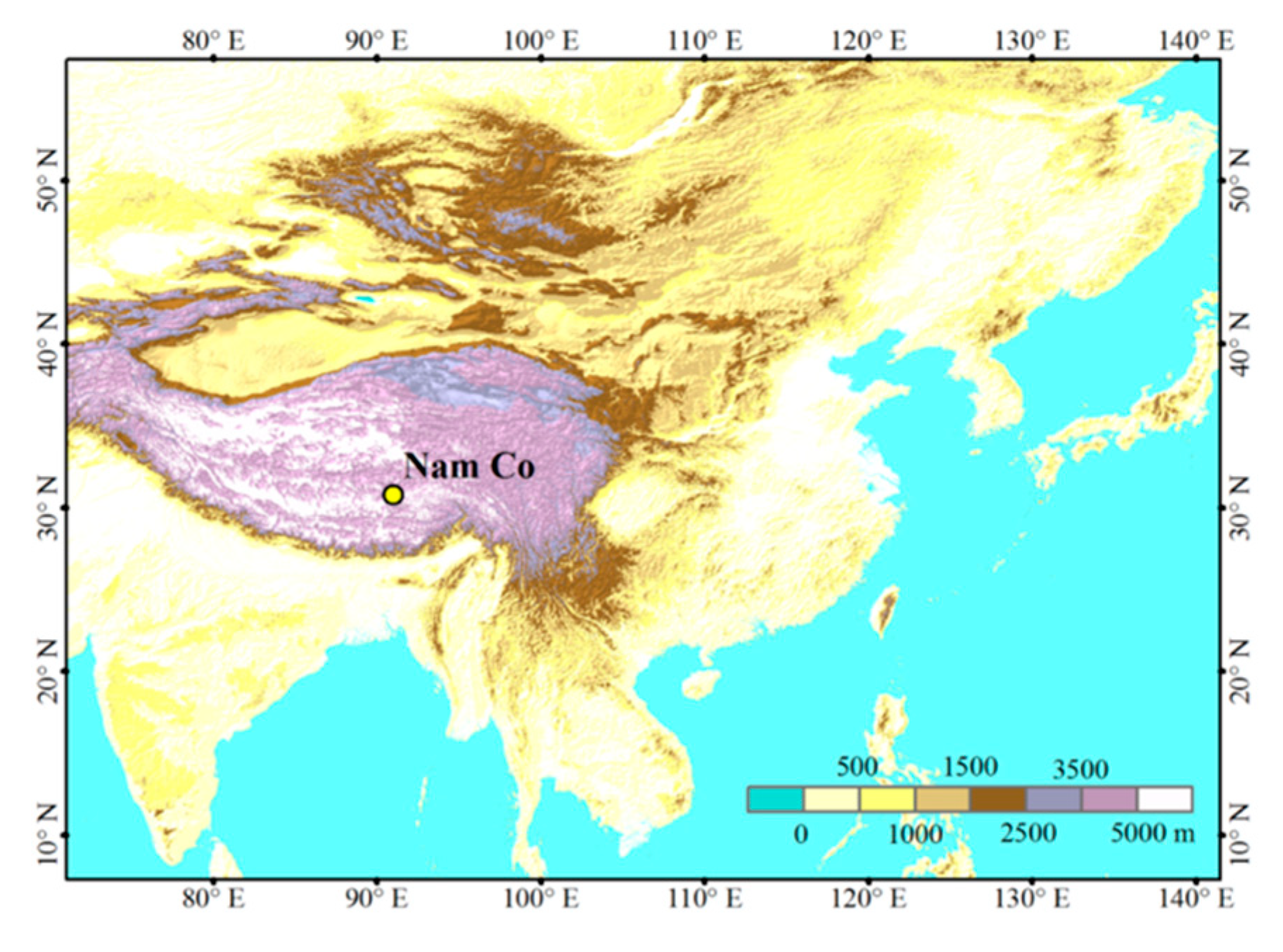
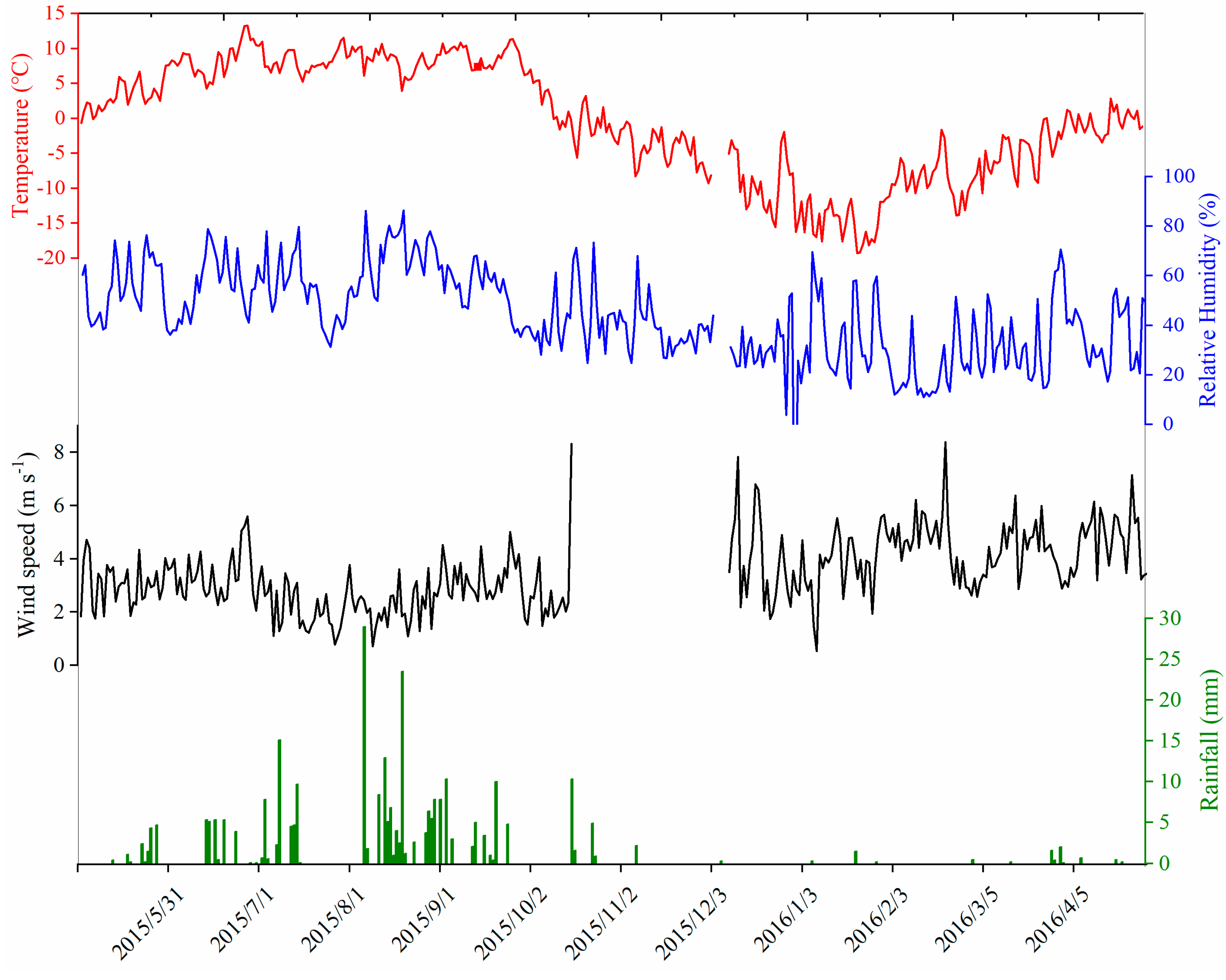
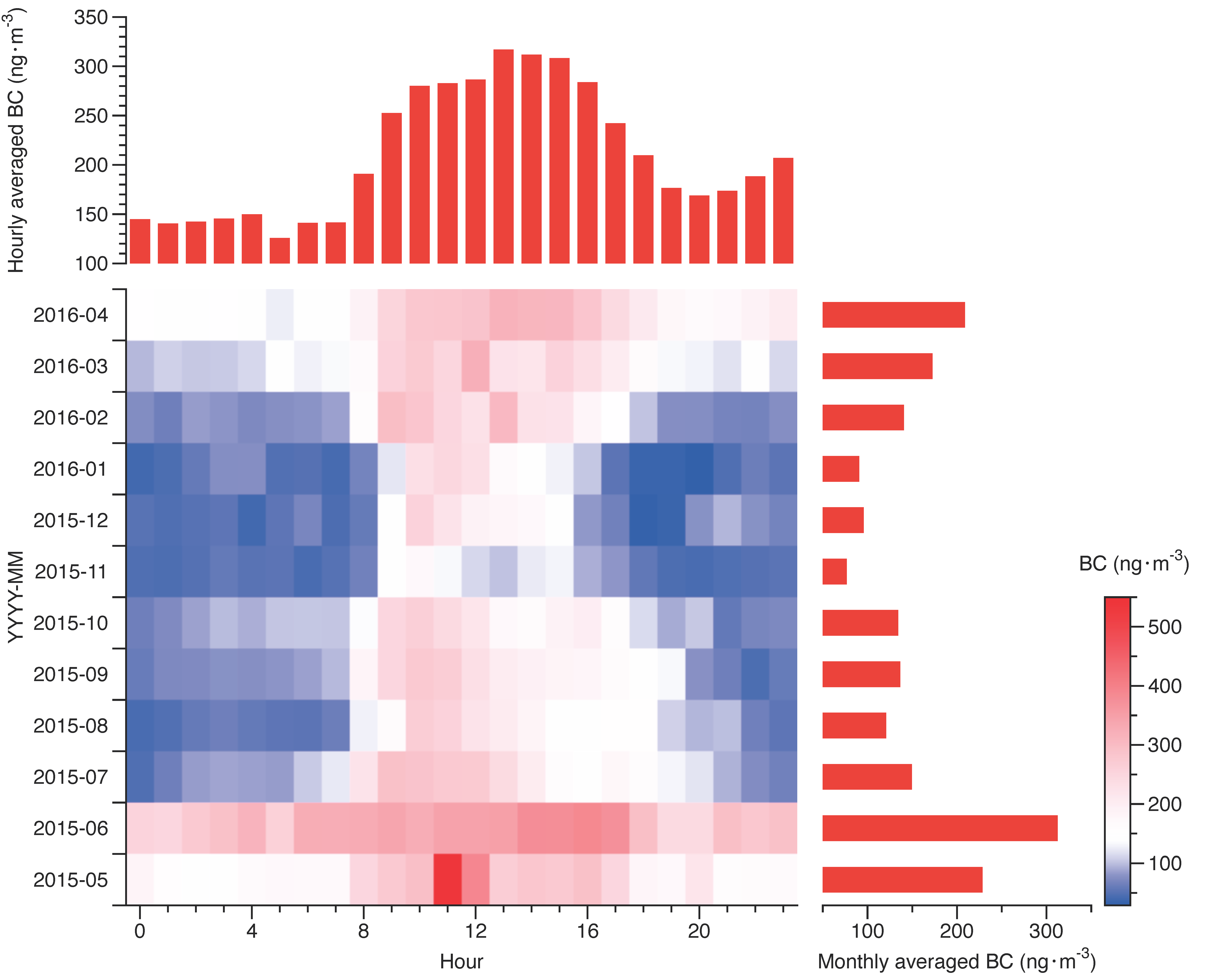
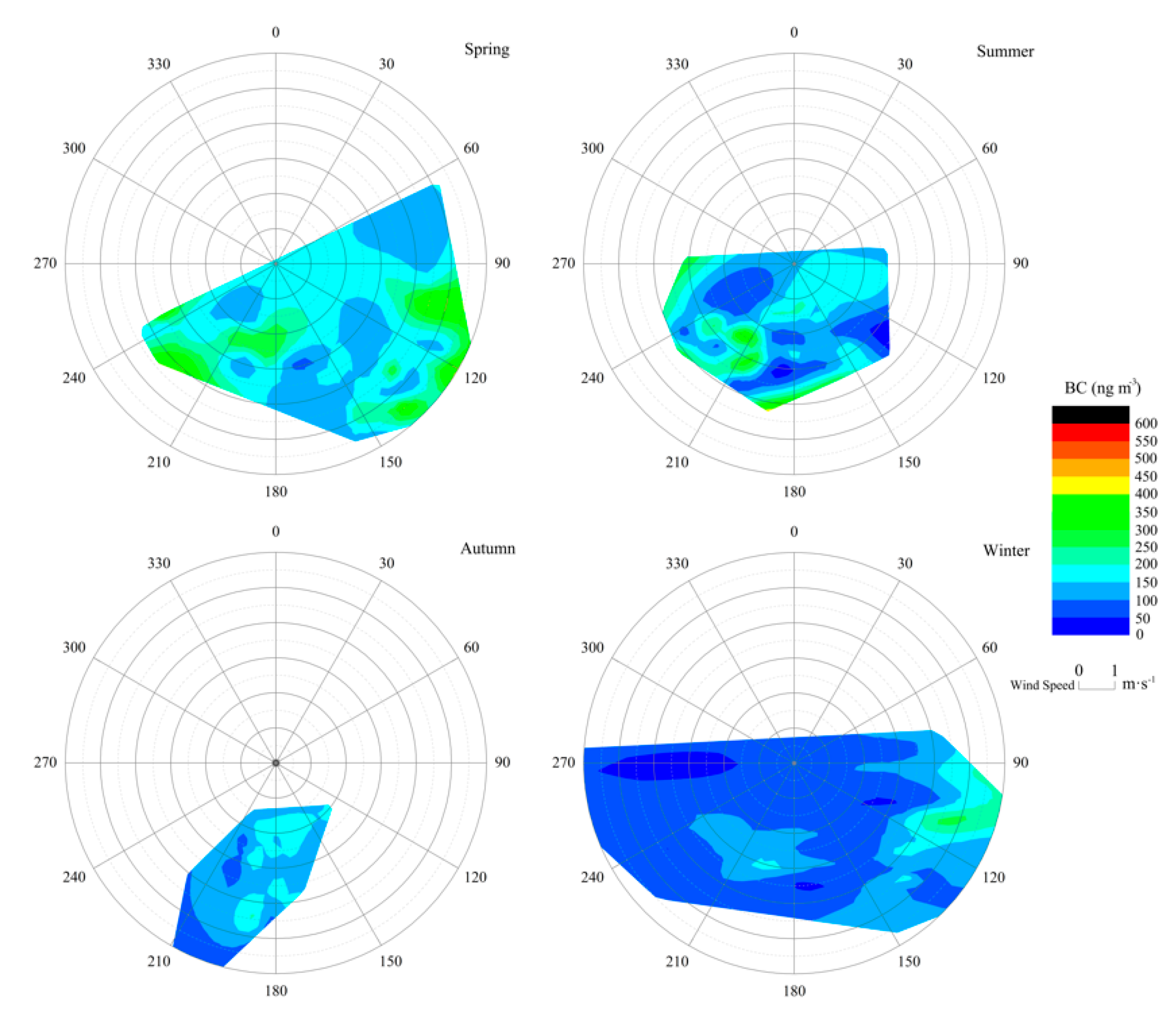
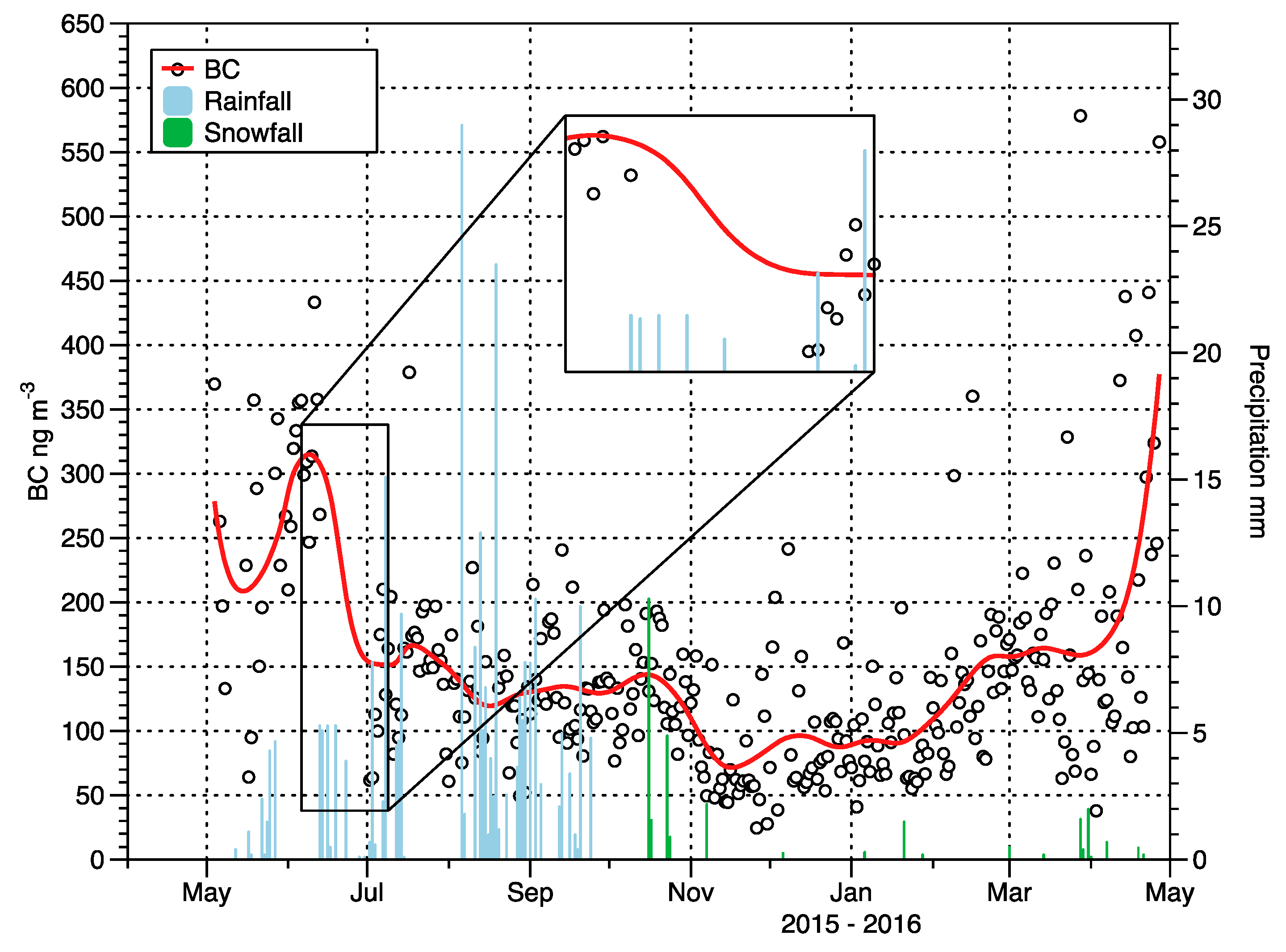
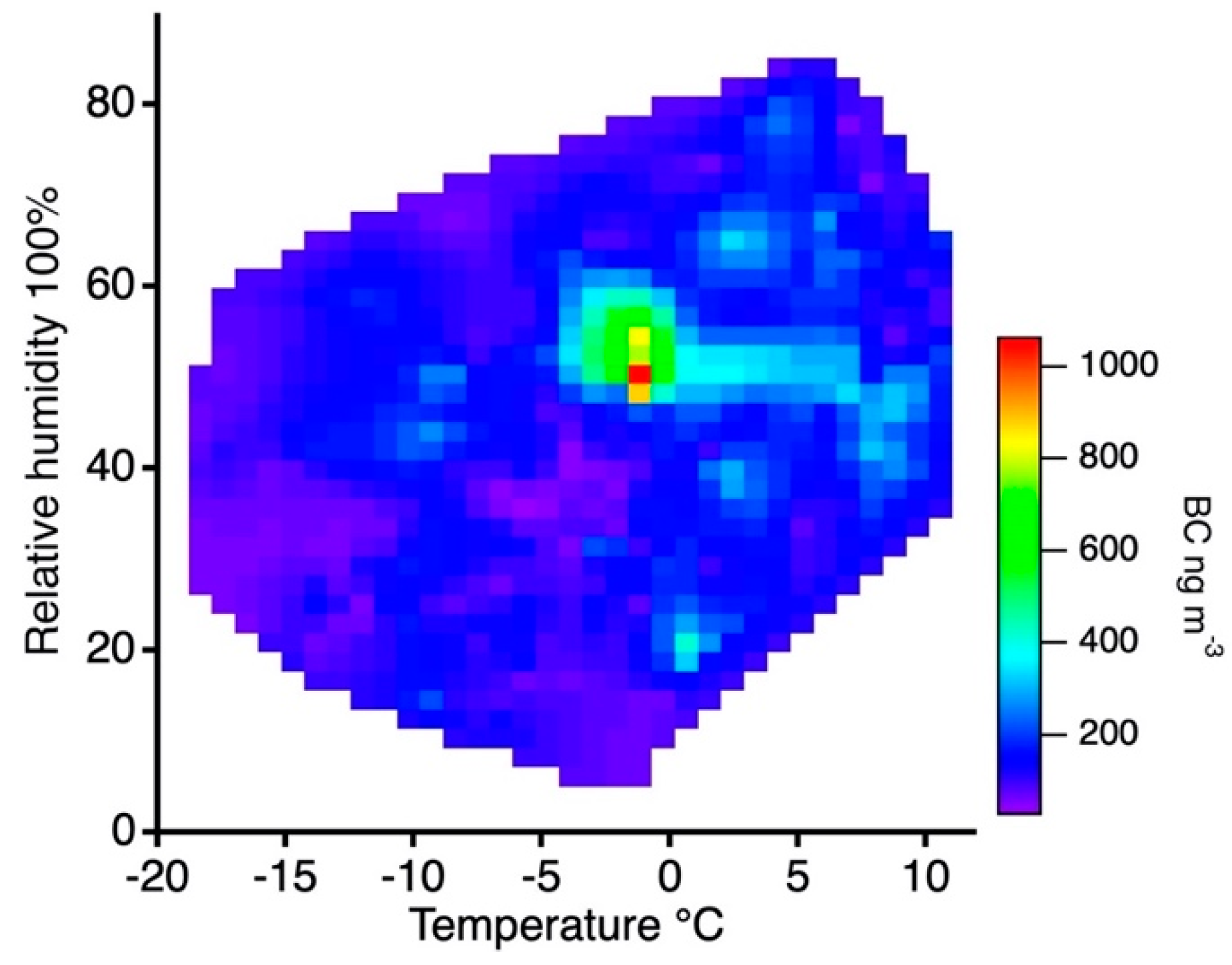
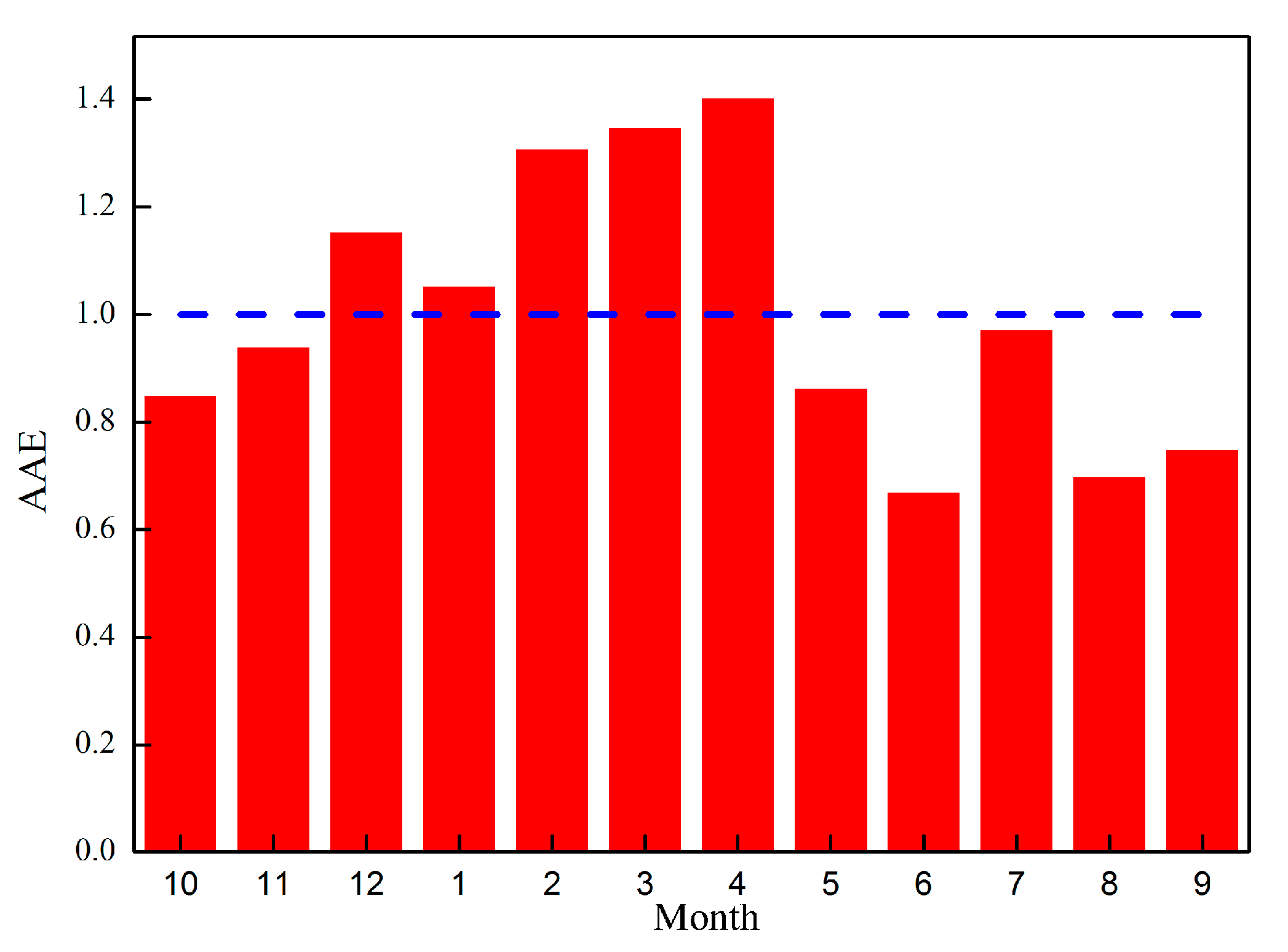
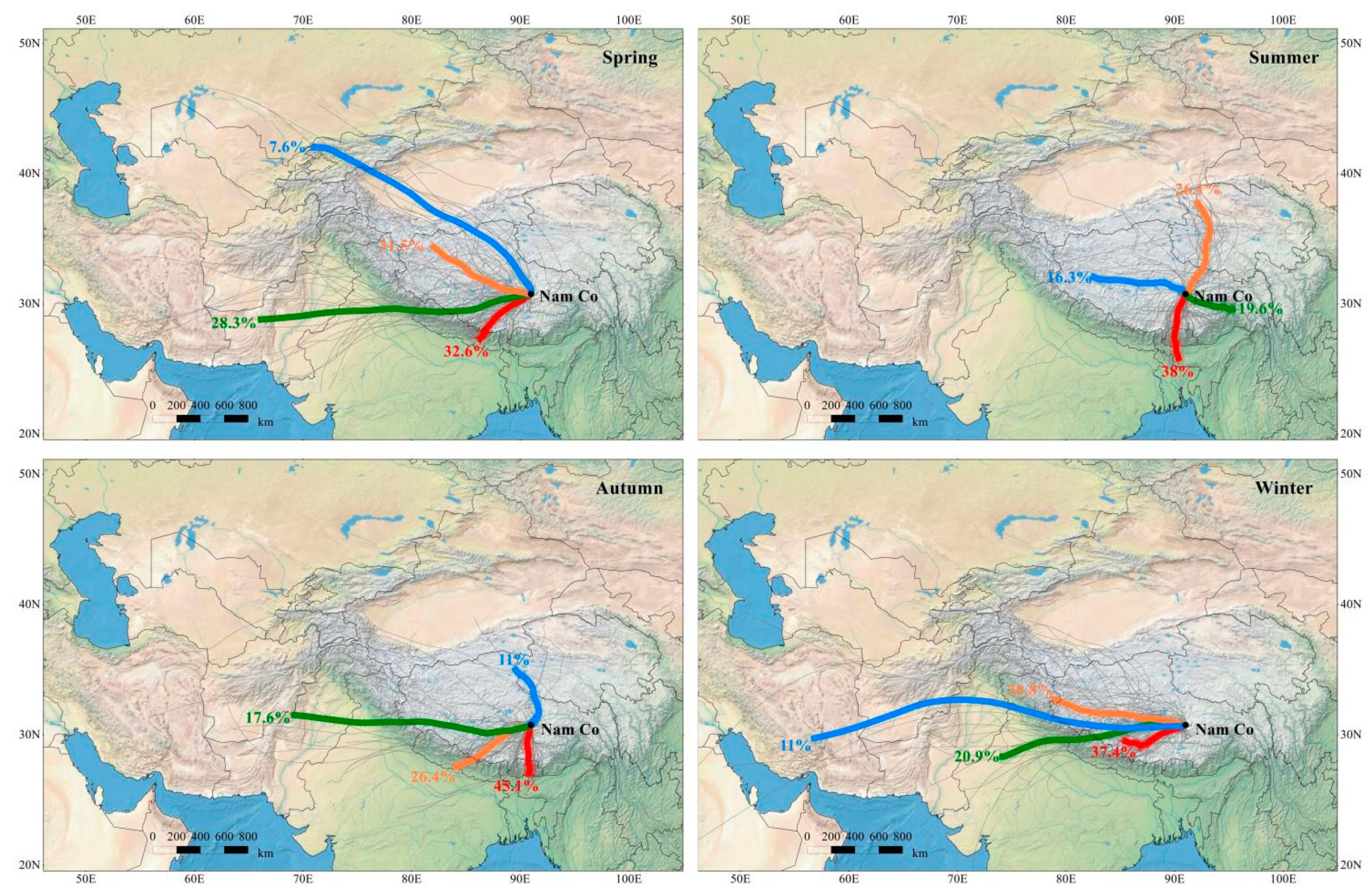
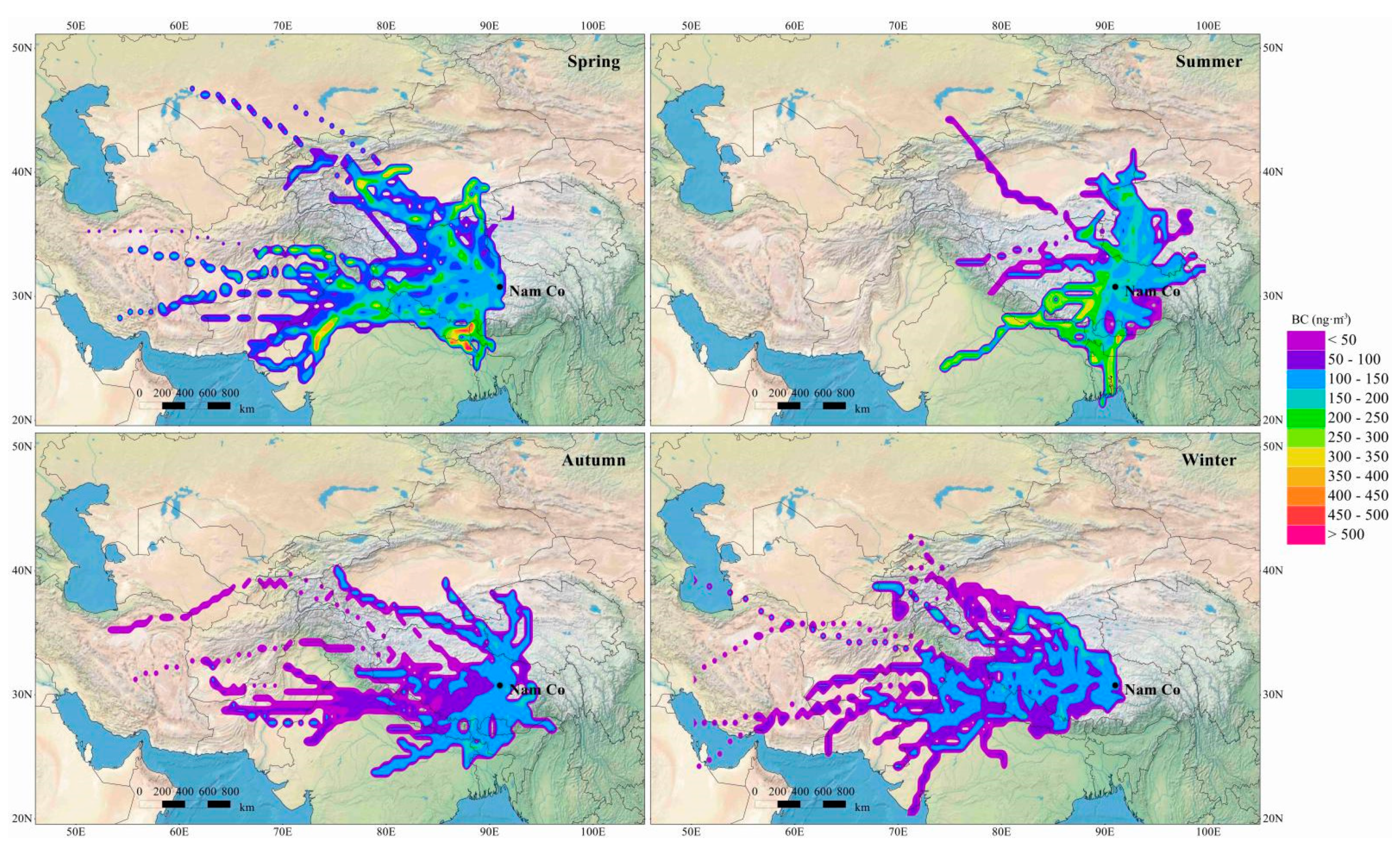
| Location | Period | Aethalometer | BC (ng·m−3) | Reference |
|---|---|---|---|---|
| Nam Co | May 2015–April 2016 | AE-31 | 145 ± 85 | This study |
| Waliguan | July 1994–December 1995 | AE-10 | 130–300 | [11] |
| Qilian Shan | May 2009–March 2011 | AE-31 | 18–72 | [36] |
| Muztagh Ata | November 2009–September 2010 | AE-16 | 133 | [37] |
| Ranwu | November 2012–June 2013 | AE-31 | 276 | [38] |
| Beiluhe | November 2012–June 2013 | AE-31 | 413 | [38] |
© 2020 by the authors. Licensee MDPI, Basel, Switzerland. This article is an open access article distributed under the terms and conditions of the Creative Commons Attribution (CC BY) license (http://creativecommons.org/licenses/by/4.0/).
Share and Cite
Wang, F.; Zhang, X.; Yue, X.; Song, M.; Zhang, G.; Ming, J. Black Carbon: The Concentration and Sources Study at the Nam Co Lake, the Tibetan Plateau from 2015 to 2016. Atmosphere 2020, 11, 624. https://doi.org/10.3390/atmos11060624
Wang F, Zhang X, Yue X, Song M, Zhang G, Ming J. Black Carbon: The Concentration and Sources Study at the Nam Co Lake, the Tibetan Plateau from 2015 to 2016. Atmosphere. 2020; 11(6):624. https://doi.org/10.3390/atmos11060624
Chicago/Turabian StyleWang, Feiteng, Xin Zhang, Xiaoying Yue, Mengyuan Song, Guoshuai Zhang, and Jing Ming. 2020. "Black Carbon: The Concentration and Sources Study at the Nam Co Lake, the Tibetan Plateau from 2015 to 2016" Atmosphere 11, no. 6: 624. https://doi.org/10.3390/atmos11060624
APA StyleWang, F., Zhang, X., Yue, X., Song, M., Zhang, G., & Ming, J. (2020). Black Carbon: The Concentration and Sources Study at the Nam Co Lake, the Tibetan Plateau from 2015 to 2016. Atmosphere, 11(6), 624. https://doi.org/10.3390/atmos11060624





